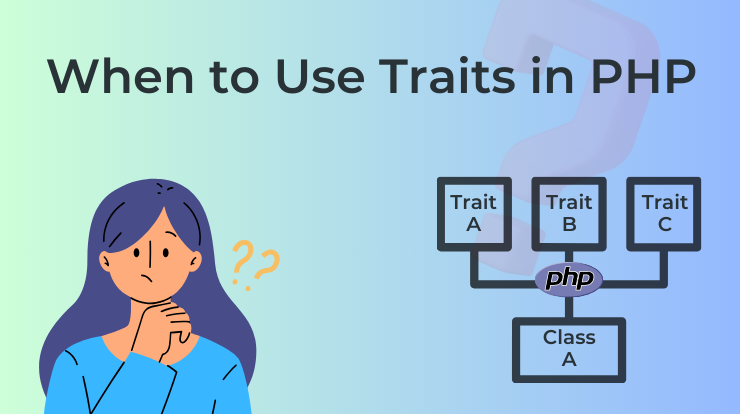Traits are a fascinating feature in PHP that often fly under the radar for many developers. In this guide, we delve deeper into the world of traits, exploring not only when to use them but also how to use them effectively.
Let’s embark on a journey to uncover the various scenarios where traits can be invaluable and how they can elevate your PHP projects to new heights of code reusability and maintainability.
What are the Traits in PHP?
Before we delve into the applications of traits, let’s ensure we understand what traits are and how they function within PHP.
Traits provide a mechanism for code reuse in PHP, offering a way to inject methods into classes without relying on traditional inheritance. Think of traits as a set of methods that can be included within any class, providing a modular approach to sharing functionality across different parts of your application.
When to Use Traits?
Let’s see the different scenarios when you can use the traits in PHP projects.
One of the prime use cases for traits is when you have methods that can be shared across multiple classes that aren’t related by inheritance. Traits allow you to mix functionality into various classes without creating complex inheritance chains.
For example, suppose you have classes representing different vehicles like Car, Bicycle, and Truck, but they all need a method to calculate their speed. Instead of creating a superclass just for this purpose, you can define a SpeedCalculator trait and use it in each class.
trait SpeedCalculator {
public function calculateSpeed($distance, $time) {
return $distance / $time;
}
}
class Car {
use SpeedCalculator;
// Car specific properties and methods
}
class Bicycle {
use SpeedCalculator;
// Bicycle specific properties and methods
}
class Truck {
use SpeedCalculator;
// Truck specific properties and methods
}
// Usage
$car = new Car();
echo $car->calculateSpeed(100, 2); // Output: 502. Avoiding Code Duplication
Traits come in handy when you find yourself duplicating code across multiple classes. Instead of copy-pasting the same methods into each class, you can extract them into a trait and reuse them wherever necessary. This not only reduces duplication but also makes your code more maintainable and less prone to errors.
trait Logger {
public function log($message) {
echo "[" . date('Y-m-d H:i:s') . "] $message\n";
}
}
class UserManager {
use Logger;
public function addUser($user) {
// Add user logic
$this->log('User added: ' . $user);
}
}
class ProductService {
use Logger;
public function addProduct($product) {
// Add product logic
$this->log('Product added: ' . $product);
}
}
// Usage
$userManager = new UserManager();
$userManager->addUser('John Doe');
$productService = new ProductService();
$productService->addProduct('Laptop');3. Horizontal Composition
Traits allow you to compose classes horizontally, meaning you can mix multiple traits into a single class to combine their functionalities. This makes it easier to manage and organize your codebase, as you can group related functionalities into separate traits and mix them as needed.
trait Loggable {
public function log($message) {
echo "Logging: $message\n";
}
}
trait Cacheable {
public function cache($data) {
echo "Caching: $data\n";
}
}
class DataService {
use Loggable, Cacheable;
public function fetchData() {
// Fetch data logic
$this->log('Data fetched');
$this->cache('Cached data');
}
}
/ Usage
$dataService = new DataService();
$dataService->fetchData();Best Practices and Considerations
While traits offer numerous benefits, it’s essential to approach their usage with care and consideration.
- Avoid Trait Overuse: While traits can streamline code organization, excessive reliance on traits can lead to a convoluted and difficult-to-understand codebase. Use traits judiciously and prioritize clarity and simplicity in your design.
- Mind Method Name Clashes: Be mindful of potential conflicts between method names within traits and classes. If a class implements multiple traits with conflicting method names, you may encounter collisions that require manual resolution.
- Document Trait Usage: Clearly document the purpose and usage of traits within your codebase to aid understanding and maintainability for yourself and other developers.
More Practical Examples of Trait Usage
Let’s explore some real-world scenarios where traits can be featured in improving code organization and reusability.
Example 1: Implementing Caching Functionality
Suppose you have multiple classes within your application that require caching functionality. Instead of duplicating the caching logic across each class, you can create a Cachable trait and incorporate it wherever caching is needed. This approach not only streamlines your code but also simplifies maintenance and updates to the caching mechanism.
trait Cachable {
public function cache($data) {
// Cache data logic
}
}
class DataService {
use Cachable;
public function fetchData() {
// Fetch data logic
$this->cache('Cached data');
}
}Example 2: Enforcing Access Control
Imagine you have various components within your application that require access control mechanisms. By defining an AccessControl trait, you can encapsulate authentication and authorization logic, ensuring consistent enforcement of access policies across different parts of your application.
trait AccessControl {
public function authenticateUser() {
// Authentication logic
}
public function authorizeAccess() {
// Authorization logic
}
}
class SecureResource {
use AccessControl;
public function accessResource() {
$this->authenticateUser();
$this->authorizeAccess();
// Access resource logic
}
}Conclusion
In conclusion, traits are a powerful tool in PHP development, offering a flexible and modular approach to code reuse and organization.
By leveraging traits effectively, you can enhance the reusability, maintainability, and clarity of your codebase, ultimately leading to more robust and scalable applications.
PHP Tutorials
FAQs
PHP traits are used to share methods among classes, enhancing code reusability without creating complex inheritance hierarchies.
Traits in PHP are similar to classes but cannot be instantiated on their own. They are used to provide methods that can be reused in multiple classes.
Yes, PHP classes can use multiple traits, allowing them to inherit functionality from different sources and promoting code modularity.
Yes, traits in PHP support method overriding. If a class uses multiple traits that define the same method, the method from the last trait included takes precedence.
While traits can be beneficial for code reuse, they should be used judiciously. Overuse of traits can lead to code complexity and reduced readability.






